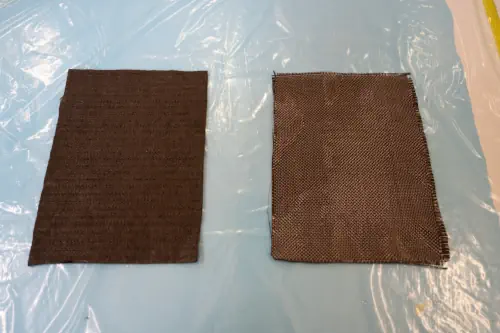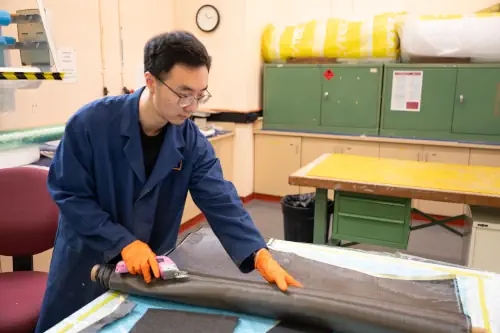Confronting the Challenges of Carbon Fiber Recycling

A UNSW Canberra researcher claims to have advanced CF recycling. But major challenges remain, says one industry expert.
Carbon fiber composites are super strong super lightweight and super difficult to recycle effectively.
Embedded in a (usually thermoset) polymer matrix, carbon fibers are commonly compounded in materials used to build very high-performance products such as aircraft, racing cars, wind turbines and high-end sports equipment like tennis rackets, hockey sticks and bicycles.

UNSW Canberra researcher Dr. Di He used sheets of carbon fiber to test his new method of recycling. He says his new approach resulted in 50 percent less degradation of the fiber. Courtesy of UNSW Canberra
Dr. Di He at the University of New South Wales Canberra in Australia says that, until now, recycling carbon fiber had always resulted in the material being heavily degraded.
“The existing method of recycling involves shredding the composite, which destroys the carbon fiber, before heating it to remove the plastic,” He is quoted as saying in an article posted on the UNSW Sydney website. “After it has been shredded, the fibers look like individual hairs or cotton wool strands.”
That means that recycled carbon fiber typically can be reused only in lower-value products such as tables or chairs that don’t experience heavy forces or loads. This doesn’t help electric vehicle makers, for example, who would love to have access to lots of high-strength, lightweight, recycled CF for certain automotive parts.

Carbon fiber recycled using the old method (left) compared with Dr. He’s new method (right). The recycled carbon fiber on the right is said to be stronger with the potential to be turned into more advanced products. Courtesy of UNSW Canberra
He claims to have developed a recycling process that wastes less of the material and also uses less energy, resulting in more usable repurposed material. “In our method,” He explains, “we don’t shred the carbon fiber and we optimized how we heat it in a furnace. Our method degrades the carbon fiber by less than 30 percent, which is a 50 percent improvement on existing methods.”
One of the lead researchers from the UNSW Canberra Advanced Manufacturing Research Group, associate professor Matthew Doolan, together with Dr. He and their collaborators, published their findings regarding recycling carbon fiber in the journal Composites Part A: Applied Science and Manufacturing.

Talon Technology CEO Geoff Germon: Hurdles remain, but realizing a thermoplastic matrix for carbon fiber composites may be one key. Courtesy of Talon Technology
Scientists have been tackling this challenge for years, with little luck to date. And, even with UNSW’s reported advances, serious challenges remain to the goal of recycling large quantities of high-quality carbon fiber, notes Geoff Germon, founder and CEO of Sydney-based Talon Technology, a composites research and development company that specializes in carbon fiber-reinforced consumer products.
Germon, who is also an adjunct professor of design at the University of Canberra, notes there have been many attempts in universities to recycle carbon fiber, but they always tend to encounter two problems:
- It is difficult to find enough carbon parts to recycle, since most products manufactured using the material are not made to be disposable and last for years; and
- The products made from carbon fiber tend to be very reliant on the quality of the material, so compromising your product for a minor savings in materials cost doesn’t really work. For example, Germon said: “My automotive wing mirror covers have A$4 worth of carbon and cost over A$700 to replace (each), so saving A$2 on the materials cost won’t make them A$350.”
Researching carbon fiber recycling is a crowded field — as evidenced by this March 2021 article from the University of Sydney — and the end goal may well end up being worth the effort.
Still, significant hurdles remain to seeing a major breakthrough. One vital development may hold the key, according to Germon: “I think this will change if carbon in a thermoplastic matrix become more popular.”
